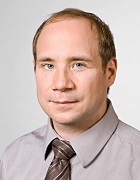
Prof. Dr. Michael Groll
Academic Career and Research Areas
Prof. Dr. Groll (b. 1971) conducts research in the field of biochemistry, investigating the structure and function of biological multimeric protein complexes. He is also interested in the basic structure of protein-protein and protein-ligand interactions. Another area of research is the medical relevance of synthetic and natural molecules in terms of their interaction with proteins.
After studying chemistry at TUM, Prof. Groll did his doctorate in biophysics under Prof. Dr. R. Huber at the Max Planck Institute in Martinsried, Munich. In 2002, he was invited to work under Prof. Dr. Finley at the Harvard Medical School. From 2003 to 2006, he organized an independent junior research group at Munich’s Ludwig Maximilian University. He completed his qualification as a lecturer in biochemistry in 2004 externally under the supervision of Prof. Dr. P. Kloetzel at the Charité in Berlin. He was a preclinical junior professor there from 2006 to 2007. Since 2007, he has held the position of full professor of biochemistry at TUM.
Key Publications
Ecker F, Vattekkatte A, Boland W, Groll M: „Metal-dependent enzyme symmetry guides the biosynthetic flux of terpene precursors”. Nature Chemistry 2023, 15: 1188-95.
AbstractBräuer A, Zhou Q, Grammbitter GLC, Schmalhofer M, Rühl M, Kaila VRI, Bode HB, Groll M: “Structural Snapshots of the Minimal PKS System Responsible for Octaketide Biosynthesis”. Nature Chemistry 2020; 12: 755-63.
AbstractHuber EM, Basler M, Schwab R, Heinemeyer W, Kirk C, Groettrup M, Groll M: "Constitutive and immunoproteasome crystal structures reveal differences in substrate and inhibitor specificity". Cell. 2012; 148: 727-38.
AbstractSchreiner P, Chen X, Husnjak K, Randles L, Zhang N, Elsasser S, Finley D, Dikic I, Walters K, Groll M: “Ubiquitin docking at the proteasome via a novel PH domain interaction”. Nature. 2008; 453: 548-52.<o:p></o:p>
AbstractGroll M, Ditzel L, Löwe J, Stock D, Bochtler M, Bartunik HD, Huber R: "Structure of the 20S proteasome from yeast at 2.4 Ả resolution". Nature. 1997; 386: 463-71.
AbstractIf you wish your profile to be changed or updated please contact Franz Langer.